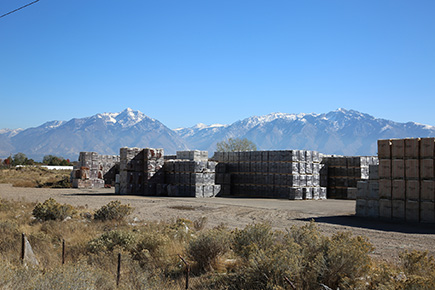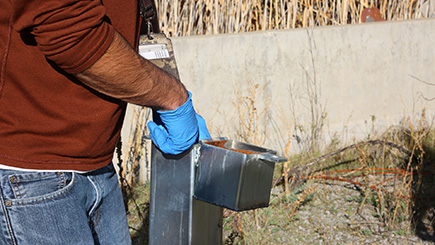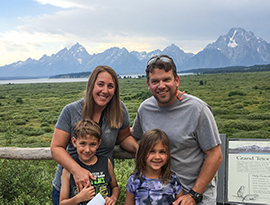By Chris Martin
I have a great job — I get to be a detective. I piece together various pieces of information — site observations, regulatory databases, records, interviews, historical documents, aerial photographs, fire insurance maps, city directories, and topographic maps — to pinpoint sources of potential contamination from past industrial activities. My detective work uncovers information that can be used in planning out investigations and performing remedial actions.

The CERCLA Branch in the Division of Environmental Response and Remediation (DERR) at the Utah Department of Environmental Quality performs site investigations of potentially contaminated sites within the State of Utah to determine whether or not they pose a threat to human health and the environment and should be included on the federal Superfund National Priorities List (NPL). The Branch also manages or performs oversight of remediation activities at NPL sites and federal facility sites, promotes the voluntary cleanup of contaminated sites, and encourages redevelopment of Brownfields by providing a streamlined cleanup program. The streamlined cleanup program often includes coordination with the underground storage tank (UST) Branch and other DEQ divisions.
The Site Assessment program is the initial phase of the federal Superfund program. Environmental personnel perform preliminary assessments and field investigations of potentially contaminated sites to determine if they should be included on the NPL. In addition, the Site Assessment program coordinates with the Environmental Protection Agency (EPA) Removals Branch. This branch responds to oil spills, chemical, biological, radiological, and nuclear incidents, and large-scale national emergencies including homeland-security incidents.
Historic Contamination

Most of Utah’s current cleanup sites are related to historic events and existing resources. These spawned two important industries: steel manufacturing and defense contracting (particularly aerospace manufacturing). Later, electronics and computers became another important industry in Utah.
Completion of the world’s first transcontinental railroad at Promontory, Utah, occurred about the same time as the first mining district was established in Utah. The railroad brought finished goods from other parts of the country, spurring growth. The onset of World War II led to a huge expansion of manufacturing throughout the west. During and shortly after World War II, the federal government spent billions of dollars nationally on manufacturing facilities and scientific research, and much of that money was spent in Utah.
Probably the biggest federal government investment in manufacturing in the state was the Geneva Steel Works in Utah County. This $200 million project permanently altered Utah’s manufacturing structure. The federal government felt it necessary to have a steel plant away from the coasts so it would less likely to be a target of enemy attack.
Steel manufacturing was not the only industry the federal government helped establish in Utah. During the second decade after World War II, another major industry began to develop defense-manufacturing facilities. In 1956, Sperry Rand Corporation (now Unisys) came to Utah to build missiles. Two years later, Thiokol Corporation located a plant west of Brigham City to build solid-fuel propellants for the Minuteman missiles. Established companies like Hercules Corporation, which located in Bacchus, Utah, in 1914 to produce blasting powder for mining, shifted to defense contracting as the need for these products increased. In 1958, the company entered the aerospace industry by producing rocket engines.
Growth of the aerospace industry in Utah accelerated with the arrival of McDonnell-Douglas in 1987. One of the two giant airplane manufacturers in the United States, McDonnell-Douglas employed about 600 people in Utah and produced parts here for the company’s airplanes. McDonnell Douglas and Boeing merged in 1996 and became one of the largest aerospace companies in the world. Boeing still operates in Utah.
Computer software and electronics are other recent growth industries in the state; examples include Novell and WordPerfect. Founded in 1983, Novell became an industry leader in designing computer software “local area network,” or LAN systems. These two companies established a base in Utah for what is now the largest tech sector growth in the United States in an area dubbed the “Silicon Slopes.”
From Contamination to Beneficial Reuse
While industries brought jobs and prosperity to Utah, some of them left behind a legacy of contamination. Many companies used toxic chemicals in the manufacturing process, and production wastes that would now be considered hazardous were stored onsite, sometimes leaking into the soils and groundwater below. In addition, environmental regulations at the time were either non-existent or very lax.

These contaminated sites, however, are becoming increasingly important as developable land as Utah grows. The Kem C. Gardner Policy Institute estimates that the Utah population will reach about 5.8 million by 2065. Returning these lands to beneficial reuse is a high priority in the state, not only for economic development but also for the protection of groundwater and soils.
For example, Vineyard, the city near the former Geneva Steel mill, has become one of the fastest growing areas in Utah. Monitoring groundwater at the site is important for the health of the businesses and families near or on the former manufacturing area. Hundreds of support businesses sprung up around the steel mill while it was in operation. After the mill shut down, many of the businesses shuttered also, some of them leaving contamination behind.
DERR plays an important role in the beneficial reuse of these properties through our investigation and assessment of the type and extent of contamination both on and offsite. Our detective work ensures the appropriate cleanup and remediation of these lands so they can be a place for Utah residents to live, work, and play.
To learn more about our work cleaning up land for beneficial reuse, visit the Division of Environmental Response and Remediation (DERR) CERCLA web pages or the DEQ State of the Environment Report, where you can see descriptions of some of the businesses, municipalities, and schools we’ve assisted with cleanup efforts.

I have been an environmental scientist at DERR for about 6 years. Prior to working at DEQ, I worked as an environmental consultant. I received a bachelor’s degree in geological engineering from the University of Utah. I have a wonderful wife, two crazy kids, and a furry dog. We spend most of our vacations exploring. This past year, we hit Glacier, Yellowstone, and Grand Teton National Parks.
